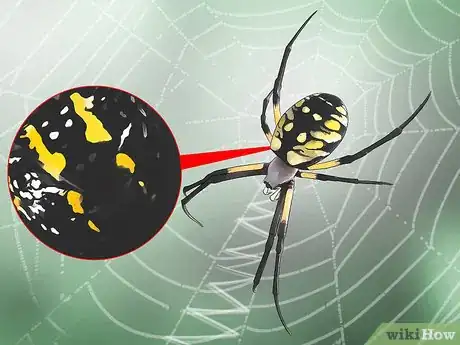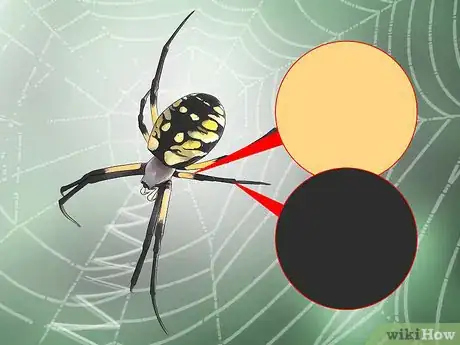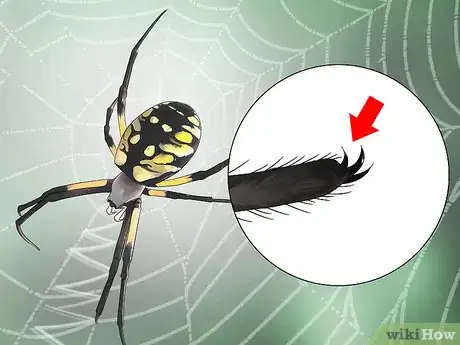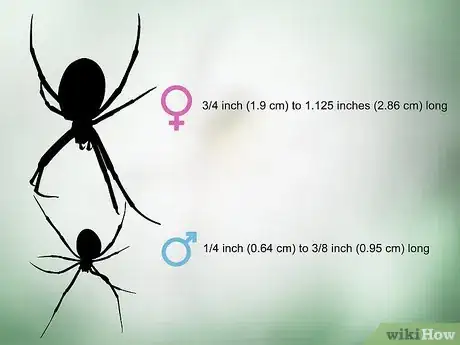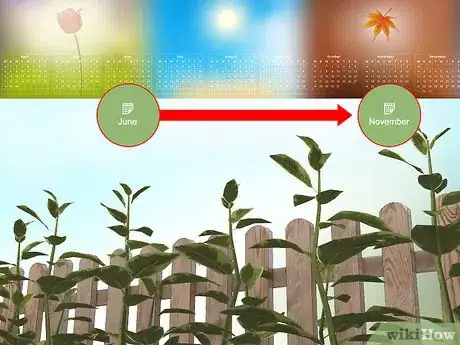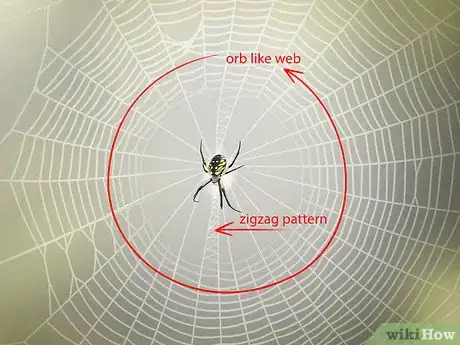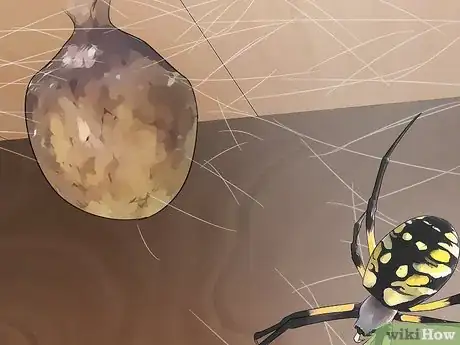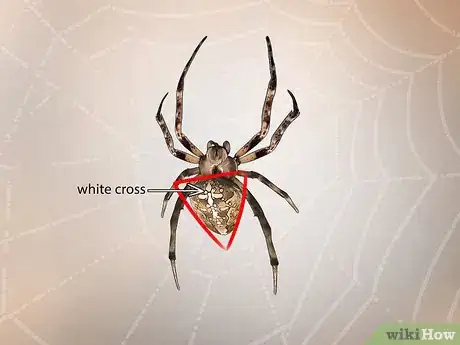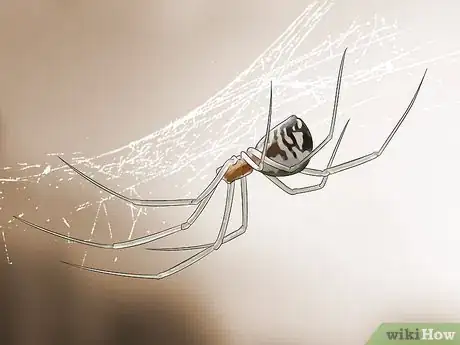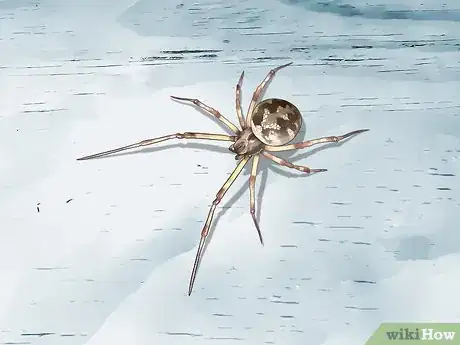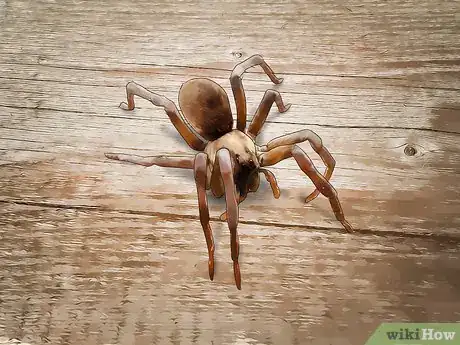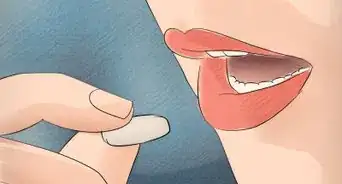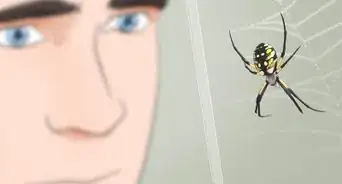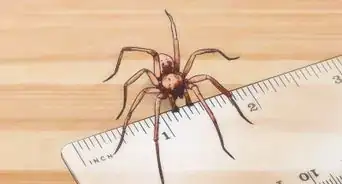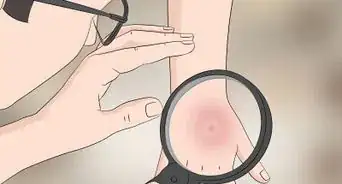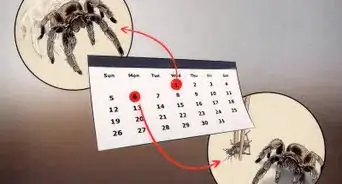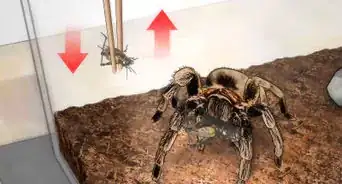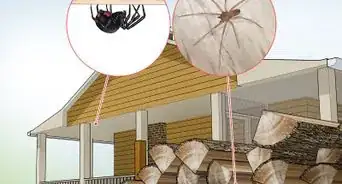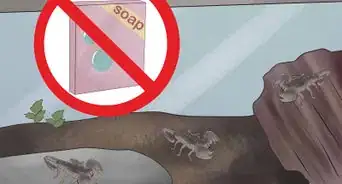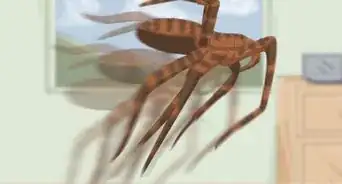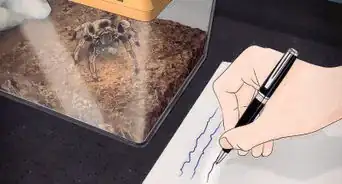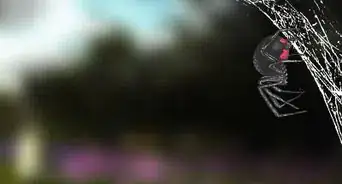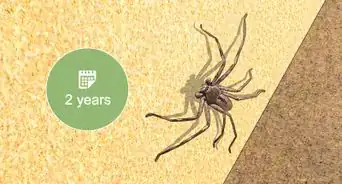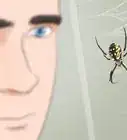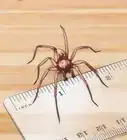This article was co-authored by Shweta Sharma. Shweta Sharma is a Biologist with the U.S. Environmental Protection Agency (EPA). With nearly ten years of experience, she specializes in insect management, integrated pest management, insect behavior, resistance management, ecology, and biological control. She earned her PhD in Urban Entomology and her MS in Environmental Horticulture from the University of Florida. She also holds a BS in Agriculture from the Institute of Agriculture and Animal Sciences, Nepal.
This article has been viewed 104,204 times.
The common garden spider (Argiope aurantia) is an orb-weaver, which means it spins its web in a spiraling circle. They are non-venomous, beneficial to the local ecosystem, and can be found just about everywhere in North America and Europe. They can resemble other spiders to an untrained eye, so be careful when trying to identify one, especially in places where venomous spiders are abundant.
Steps
Observing the Spider Directly
-
1Look for an egg-shaped black abdomen with yellow patches. The abdomen of a garden spider is egg-shaped and slightly shiny, which helps when trying to find them in direct sunlight. A female abdomen will be black with patches of bright yellow, whereas males have patches of pale yellow coloration.[1]
-
2Note if the front body section of the spider has short, silvery hairs. Most spiders have short hairs on their legs, but the garden spider has silvery-grey hairs on both its cephalothorax (the front section of its body) and its legs. Check for these with a magnifying glass (or camera with a zoom function), but be careful not to concentrate the sun's rays on the spider and burn it.[2]Advertisement
-
3Check the legs for yellow or red coloring that turns black at the end. Garden spiders have legs that are distinctly separated into 2 colors — the part closest to the body is yellow or reddish-orange while the tip of the leg becomes black. The colors do not blend and change abruptly near the first bend in its leg.[3]
- In some spiders, the colors band around each leg rather than separate into 2 distinct colors. This is relatively uncommon but is something that should be taken into account when you look at its leg coloration.
-
4Notice if it has 3 claws at the end of each leg. Most spiders have 2 claws at the end of each leg, but because the garden spider is an orb-weaver, it needs an extra claw to handle its silk while making its web.[4]
-
5Figure out whether it is a female or male spider by its size. Unlike humans, the female garden spider is much larger than the male garden spider, sometimes up to 4 times its size.[5] Female garden spiders are anywhere from 3⁄4 inch (1.9 cm) to 1.125 inches (2.86 cm) long, while males can be anywhere from 1⁄4 inch (0.64 cm) to 3⁄8 inch (0.95 cm) long.[6]
- Another way to determine the spider's sex is to observe it on the web. Females will hang head-down from the center of the web with their legs kept together, so they appear to have 4 legs rather than 8.
- The male garden spider may not display its colors as much as the female spider, which makes its colors appear much more muted and pale.[7]
Recognizing a Garden Spider Habitat
-
1Search for spiders in the warmer parts of the year, from spring to fall. The garden spider is most active from June to November, after which it goes dormant until the spring.[8] In places with a particularly cold winter, the spider may go dormant earlier.
- The garden spider loves the sun and warmth, which is why it is much easier to find in warm months than in winter and the beginning of spring. You can certainly still find them at other times of the year, but they will be harder to spot and may be hidden from sight entirely.
-
2Look for webs about knee-high off the ground in sunny but hidden areas. Garden spiders like to build their webs a little bit off of the ground in an area without wind or other factors that could destroy their web.[9]
- Don't limit your search to just your garden. You can often find their webs built on trellises and on fences around the house, and they are abundant in natural areas too.
- Garden spiders often like to build their webs in areas of tall grass and foliage, as the grass provides a natural buffer and hiding spot.
-
3Identify its circular, orb-like web with a zig-zag pattern. Garden spiders spin their webs in large, circular spirals often with a thick strand of silk that resembles a zig-zag going directly through the middle.[10] This is an indication that you have a garden spider in your yard, but there are other types of spiders that make their webs in a similar fashion. If you have webs that look very different from this in your garden, it is unlikely they were made by the common garden spider.
- The zig-zag strand of silk may not always be present. The spiral pattern will indicate that the web belongs to a garden spider, whereas the strand of silk will confirm this, if it is there.
-
4Notice their brown, thin egg sacs attached to one side of the web. The female will lay eggs on the web and keep them close to her, to prevent ants from getting to her spawn.[11] These round egg sacs can be up to 1 inch (2.5 cm) wide and contain many hundreds of smaller spider eggs. Rarely, if ever, will you find these eggs unattached to a web.
Identifying Other Spiders in your Garden
-
1Recognize a cross orb-weaver by its pyramid-shaped abdomen with a white cross. The cross orb-weaver is sometimes mistaken for a garden spider as it has a similar coloring, but the shape of the cross orb-weaver's abdomen, as well as the white stripe coloration on its body, differentiates it. Its web is circular and spiraling, much like the garden spider's web.[12]
-
2Identify a grass spider by its funnel-like web and brown striped legs. A grass spider is a common spider that makes its web in a funnel shape.[13] Their webs are typically low to the ground, which can indicate that it belongs to a grass spider and not a garden spider. The grass spider has black and white spots on its abdomen and brown-striped legs. Their bites are slightly venomous but do not cause any damage to people.
-
3Look for a long, narrow brown body and pale long legs in the dome spider. The dome spider's legs are noticeably longer than its body. Their body is a deep dark brown, whereas their legs are a pale tan color. Its web is shaped like a dome, and the dome spider's body has no bright coloring, unlike the garden spider.
-
4Identify a cobweb spider by its white body and legs and its large abdomen. The cobweb spider can typically be found climbing on flowers and bushes and in tangled messes of cobweb.[14] Sometimes, they will have red or black markings on their body, but this is uncommon.[15] The cobweb spider's web is erratic and patternless and is easily destroyed by the wind, which is why they are usually found in corners and out of the elements. Black widow spiders are one notable example of a venomous cobweb spider, but most are not venomous.
-
5Note the camouflage coloration and reflective eyes of the wolf spider. The wolf spider is a master of disguise and can be hard to spot without a flashlight as they blend into their surroundings extremely well. You can typically find them in open areas, and using a flashlight at night can help to find their reflective eyes looking back at you — spooky![16] Its web is small and funnel-shaped, and is usually hidden away rather than out in the open. Its bite is mildly venomous, but is not lethal.
Community Q&A
-
QuestionWere do garden spiders often live?
 Community AnswerThey often live in hedges or in a cool space like in the shade, or maybe in front of a fence or wall.
Community AnswerThey often live in hedges or in a cool space like in the shade, or maybe in front of a fence or wall. -
QuestionHow long do they generally live?
 Community AnswerGarden spiders live for about a year.
Community AnswerGarden spiders live for about a year. -
QuestionWhat can I do to protect a garden spider in a hurricane?
 Community AnswerYou could take it inside and care for it until the storm is over. lf it chooses a corner and spins a web, then let it catch some flies.
Community AnswerYou could take it inside and care for it until the storm is over. lf it chooses a corner and spins a web, then let it catch some flies.
Warnings
- The garden spider’s web can be as large as 2 feet (0.61 m) across, and although this can be a nuisance when you are working in your garden, keep in mind that the garden spider is very beneficial to the ecosystem. If you constantly destroy their webs, they will leave.⧼thumbs_response⧽
- The garden spider is not venomous and it is not aggressive. A bite from a garden spider is extremely rare, but if you are bitten, you will not feel too much pain. Let the bite heal on its own, but use ice to numb the area if there is any minor swelling.⧼thumbs_response⧽
- If you aren't sure about what type of spider you're looking at, try taking a picture and doing a Google search.⧼thumbs_response⧽
Things You'll Need
- Magnifying glass or camera with a zoom function
References
- ↑ https://www.insectidentification.org/insect-description.asp?identification=Black-and-Yellow-Garden-Spider
- ↑ https://www.insectidentification.org/insect-description.asp?identification=Black-and-Yellow-Garden-Spider
- ↑ https://aggie-horticulture.tamu.edu/galveston/beneficials/beneficial-24_spider_blackandyellow_argiope.htm
- ↑ https://www.insectidentification.org/insect-description.asp?identification=Black-and-Yellow-Garden-Spider
- ↑ https://www.wildlifetrusts.org/wildlife-explorer/invertebrates/spiders/garden-spider
- ↑ https://aggie-horticulture.tamu.edu/galveston/beneficials/beneficial-24_spider_blackandyellow_argiope.htm
- ↑ https://www.insectidentification.org/insect-description.asp?identification=Black-and-Yellow-Garden-Spider
- ↑ https://www.wildlifetrusts.org/wildlife-explorer/invertebrates/spiders/garden-spider
- ↑ https://www.insectidentification.org/insect-description.asp?identification=Black-and-Yellow-Garden-Spider
- ↑ https://www.insectidentification.org/insect-description.asp?identification=Black-and-Yellow-Garden-Spider
- ↑ https://aggie-horticulture.tamu.edu/galveston/beneficials/beneficial-24_spider_blackandyellow_argiope.htm
- ↑ http://web.pdx.edu/~smasta/MastaSpidersYard.html
- ↑ http://web.pdx.edu/~smasta/MastaSpidersYard.html
- ↑ http://web.pdx.edu/~smasta/MastaSpidersYard.html
- ↑ http://web.pdx.edu/~smasta/MastaSpidersYard.html
- ↑ http://web.pdx.edu/~smasta/MastaSpidersYard.html
About This Article
To identify a common garden spider, look for a slightly shiny, egg-shaped black abdomen with yellow patches and short, silvery hairs on the front section of its body. You can also examine the spider's legs, which should be red or yellow close to the body and turn black at the ends. Most spiders have two claws at the end of each leg, but you'll know you're looking at a garden spider if it has three claws instead of two. For tips on recognizing a garden spider's unique web, read on!
